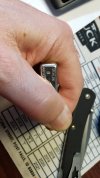- Joined
- Dec 19, 2018
- Messages
- 360
Well you have along with my Mother brought back something that was hidden in my brain until you showed me that nickel - silver does tarnish and my mother polishing silverware long ago that was brought back to memory because of you JBMONKEY. Those are fond memories of my family that were long hidden in my memory and having medicated Dementia this image popped into my vision through all the medications. I really Thank You. It was a very good experience.


